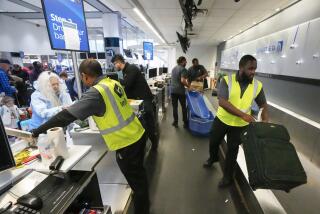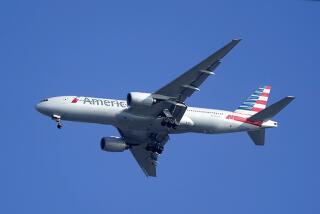New Rules Issued for Commuter Aircraft : Airlines: U.S. transportation secretary says the move will bring smaller planes up to same safety standards as the larger jetliners.
WASHINGTON — Transportation Secretary Federico Pena on Friday announced a series of safety regulations to bring smaller scheduled commercial commuter aircraft up to the same rigorous safety standards as bigger jets.
He said the new regulations, to become final by next Dec. 14, would assure commuters of a single level of safety on big and small planes alike.
Less-stringent rules now cover planes with 10 to 30 seats.
“Whether an airplane has 10 seats or 300 seats, we can assure travelers that every commercial flight will deliver the same high level of safety,” Pena told a news conference.
He had pledged to review airline safety after the crash of a commuter plane near Raleigh, N.C., last Dec. 13 that killed 15, people, the third commuter accident of 1994.
Pena said the new regulations, most of them recommended by the independent National Transportation Safety Board, are vital because commuter traffic is the fastest-growing segment of aviation.
He said commuter safety has improved since 1978, “but it still falls far short of the major carriers’ outstanding record of safety.”
He said new regulations would cover 65 airlines flying about 1,100 planes, although many of the planes are flown as regional carriers of the major airlines and already meet the tougher standards.
The Federal Aviation Administration, part of the Transportation Department, said the regulations would include requiring commuter airlines to appoint a safety officer and to standardize their ground de-icing program.
It also said they would require commuter lines to comply with the same pilot flight and rest regulations as major airlines, set duty limits for maintenance workers and require that planes carry additional passenger safety equipment.
FAA Administrator David Hinson said that some planes with 10 to 19 seats would be required to comply with the “functional equivalent” of the regulations.
He said that under this “common sense” approach, some smaller craft would not be required to carry a flight attendant, or, for instance, to have a door between cockpit and cabin.
It said the new rules are expected to cost commuter airlines $275 million over 10 years, but that the stricter requirements may prevent 75 accidents during that time.
The FAA said the passenger cost is expected to average less than $2 per one-way ticket.
It said that while compliance might cause some operators to stop flying, if the routes were profitable, other carriers might step in.
More to Read
Inside the business of entertainment
The Wide Shot brings you news, analysis and insights on everything from streaming wars to production — and what it all means for the future.
You may occasionally receive promotional content from the Los Angeles Times.










